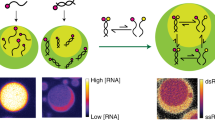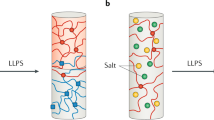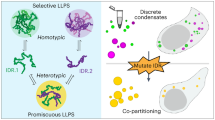Abstract
Membraneless organelles are cellular compartments made from drops of liquid protein inside a cell. These compartments assemble via the phase separation of disordered regions of proteins in response to changes in the cellular environment and the cell cycle. Here we demonstrate that the solvent environment within the interior of these cellular bodies behaves more like an organic solvent than like water. One of the most-stable biological structures known, the DNA double helix, can be melted once inside the liquid droplet, and simultaneously structures formed from regulatory single-stranded nucleic acids are stabilized. Moreover, proteins are shown to have a wide range of absorption or exclusion from these bodies, and can act as importers for otherwise-excluded nucleic acids, which suggests the existence of a protein-mediated trafficking system. A common strategy in organic chemistry is to utilize different solvents to influence the behaviour of molecules and reactions. These results reveal that cells have also evolved this capability by exploiting the interiors of membraneless organelles.
This is a preview of subscription content, access via your institution
Access options
Subscribe to this journal
Receive 12 print issues and online access
$259.00 per year
only $21.58 per issue
Buy this article
- Purchase on Springer Link
- Instant access to full article PDF
Prices may be subject to local taxes which are calculated during checkout




Similar content being viewed by others
References
Luzio, J. P., Pryor, P. R. & Bright, N. A. Lysosomes: fusion and function. Nature Rev. Mol. Cell Biol. 8, 622–632 (2007).
Boisvert, F. M., van Koningsbruggen, S., Navascues, J. & Lamond, A. I. The multifunctional nucleolus. Nature Rev. Mol. Cell Biol. 8, 574–585 (2007).
Nizami, Z., Deryusheva, S. & Gall, J. G. The Cajal body and histone locus body. Cold Spring Harb. Perspect. Biol. 2, 653 (2010).
Anderson, P. & Kedersha, N. RNA granules post-transcriptional and epigenetic modulators of gene expression. Nature Rev. Mol. Cell Biol. 10, 430–436 (2009).
Brangwynne, C. P. et al. Germline P granules are liquid droplets that localize by controlled dissolution/condensation. Science 324, 1729–1732 (2009).
Brangwynne, C. P., Mitchison, T. J. & Hyman, A. A. Active liquid-like behavior of nucleoli determines their size and shape in Xenopus laevis oocytes. Proc. Natl Acad. Sci. USA 108, 4334–4339 (2011).
Berry, J., Weber, S. C., Vaidya, N., Haataja, M. & Brangwynne, C. P. RNA transcription modulates phase transition-driven nuclear body assembly. Proc. Natl Acad. Sci. USA 112, E5237–E5245 (2015).
Nott, T. J. et al. Phase transition of a disordered nuage protein generates environmentally responsive membraneless organelles. Mol. Cell 57, 936–947 (2015).
Li, P. L. et al. Phase transitions in the assembly of multivalent signalling proteins. Nature 483, 336–129 (2012).
Elbaum-Garfinkle, S. et al. The disordered P granule protein LAF-1 drives phase separation into droplets with tunable viscosity and dynamics. Proc. Natl Acad. Sci. USA 112, 7189–7194 (2015).
Weber, S. C. & Brangwynne, C. P. Inverse size scaling of the nucleolus by a concentration-dependent phase transition. Curr. Biol. 25, 641–646 (2015).
Patel, A. et al. A liquid-to-solid phase transition of the ALS protein FUS accelerated by disease mutation. Cell 162, 1066–1077 (2015).
Lin, Y., Protter, D. S., Rosen, M. K. & Parker, R. Formation and maturation of phase-separated liquid droplets by RNA-binding proteins. Mol. Cell 60, 208–219 (2015).
Molliex, A. et al. Phase separation by low complexity domains promotes stress granule assembly and drives pathological fibrillization. Cell 163, 123–133 (2015).
Jiang, H. et al. Phase transition of spindle-associated protein regulate spindle apparatus assembly. Cell 163, 108–122 (2015).
Burke, K. A., Janke, A. M., Rhine, C. L. & Fawzi, N. L. Residue-by-residue view of in vitro FUS granules that bind the C-terminal domain of RNA polymerase II. Mol. Cell 60, 231–241 (2015).
Swedlow, J. R. & Lamond, A. I. Nuclear dynamics: where genes are and how they got there. Genome Biol. 2, 2 (2001).
Meikar, O., Da Ros, M., Liljenback, H., Toppari, J. & Kotaja, N. Accumulation of piRNAs in the chromatoid bodies purified by a novel isolation protocol. Exp. Cell Res. 316, 1567–1575 (2010).
Han, T. N. W. et al. Cell-free formation of RNA granules: bound RNAs identify features and components of cellular assemblies. Cell 149, 768–779 (2012).
Kato, M. et al. Cell-free formation of RNA granules: low complexity sequence domains form dynamic fibers within hydrogels. Cell 149, 753–767 (2012).
Pasquinelli, A. E. et al. Conservation of the sequence and temporal expression of Let-7 heterochronic regulatory RNA. Nature 408, 86–89 (2000).
Reinhart, B. J. et al. The 21-nucleotide Let-7 RNA regulates developmental timing in Caenorhabditis elegans. Nature 403, 901–906 (2000).
Aravin, A. A. et al. A piRNA pathway primed by individual transposons is linked to de novo DNA methylation in mice. Mol. Cell 31, 785–799 (2008).
Watanabe, T. et al. Identification and characterization of two novel classes of small RNAs in the mouse germline: retrotransposon-derived siRNAs in oocytes and germline small RNAs in testes. Genes Dev. 20, 1732–1743 (2006).
Baldwin, A. J. et al. Metastability of native proteins and the phenomenon of amyloid formation. J. Am. Chem. Soc. 133, 14160–14163 (2011).
Borst, J. W., Hink, M. A., van Hoek, A. & Visser, A. J. W. G. Effects of refractive index and viscosity on fluorescence and anisotropy decays of enhanced cyan and yellow fluorescent proteins. J. Fluoresc. 15, 153–160 (2005).
Suhling, K., Davis, D. M., Petrasek, Z., Siegel, J. & Phillips, D. The influence of the refractive index on EGFP fluorescence lifetimes in mixtures of water and glycerol. Proc. Soc. Photo-Opt. Ins. 2, 92–101 (2001).
Craggs, T. D. Green fluorescent protein: structure, folding and chromophore maturation. Chem. Soc. Rev. 38, 2865–2875 (2009).
Lawrence, M. S., Phillips, K. J. & Liu, D. R. Supercharging proteins can impart unusual resilience. J. Am. Chem. Soc. 129, 10110–10112 (2007).
McNaughton, B. R., Cronican, J. J., Thompson, D. B. & Liu, D. R. Mammalian cell penetration, siRNA transfection, and DNA transfection by supercharged proteins. Proc. Natl Acad. Sci. USA 106, 6111–6116 (2009).
Thiam, A. R., Farese, R. V. & Walther, T. C. The biophysics and cell biology of lipid droplets. Nature Rev. Mol. Cell Biol. 14, 775–786 (2013).
Acknowledgements
A.J.B. thanks the Biotechnology and Biological Sciences Research Council (BBSRC grant BB/J014346/1) for a David Philip's fellowship, and T.D.C. thanks the BBSRC for funding. T.J.N. thanks the BBSRC and New College for funding and O. Tkachenko, G. Hochberg, J. Hopper, S. Chandler and S. Habash for gifts of GFP-tagged proteins, E Fussner-Dupas for antibody-labelling support and B. Davis for discussion and the use of instrumentation. The authors thank L. E. Kay for discussion.
Author information
Authors and Affiliations
Contributions
T.J.N., A.J.B. and T.D.C. conceived and designed the experiments; T.J.N. and A.J.B. analysed data and wrote the manuscript with input from T.D.C.; T.J.N. performed the experiments.
Corresponding authors
Ethics declarations
Competing interests
The authors declare no competing financial interests.
Supplementary information
Supplementary information
Supplementary information (PDF 2770 kb)
Rights and permissions
About this article
Cite this article
Nott, T., Craggs, T. & Baldwin, A. Membraneless organelles can melt nucleic acid duplexes and act as biomolecular filters. Nature Chem 8, 569–575 (2016). https://doi.org/10.1038/nchem.2519
Received:
Accepted:
Published:
Issue Date:
DOI: https://doi.org/10.1038/nchem.2519
This article is cited by
-
Dipeptide coacervates as artificial membraneless organelles for bioorthogonal catalysis
Nature Communications (2024)
-
Direct prediction of intrinsically disordered protein conformational properties from sequence
Nature Methods (2024)
-
Rational design of phase separating peptides based on phase separating protein sequence of p53
Scientific Reports (2023)
-
Liquid spherical shells are a non-equilibrium steady state of active droplets
Nature Communications (2023)
-
(Dys)functional insights into nucleic acids and RNA-binding proteins modulation of the prion protein and α-synuclein phase separation
Biophysical Reviews (2023)



